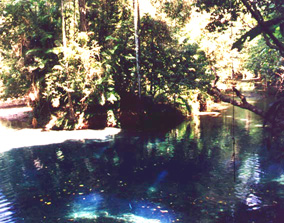How does Australia reconcile the most singularly sacred site in the Daintree to its Indigenous custodians with a publicly popular treasure at the centrepiece of the Daintree World Heritage rainforest? Such is the challenge of a James Cook University research team, commissioned with the development of a management plan to investigate environmental, cultural and recreational values.
The Blue Pool (depicted below as it was 1995) is located within loci of exceptionally high environmental values. The Cooper Creek area is renowned for its outstanding biological diversity and the Blue Pool precinct has representative habitats of many endemic, rare and restricted plant and animal species.
The rainforest about the Blue Pool is structurally classified as complex mesophyll vine forest: the ultimate expression of rainforest in Australia. It is also one of the most endangered rainforest systems in the wet tropics region. This rainforest type is especially noted as being the habitat for many rare and threatened species located within the precinct.
Advertisement
The Blue Pool is also sacred to the Kuku Yalanji traditional owners as a birthing site and spiritual repository for the stillborn, since time immemorial. Its pristine condition, prior to popular recreational access, was testimony to traditional management practices.

Cooper Creek Wilderness is a private-sector manager of the northern bank (the viewing side of the picture above), which is freehold land within the Wet Tropics World Heritage Area. The southern bank is a local government road reserve held under trust by Douglas Shire Council (DSC).
For over ten years, Cooper Creek Wilderness has steadfastly refused to allow public access to the Blue Pool. This stance accords with its respect for the wishes of the traditional owners, but also to comply with its recognition of managerial necessity and the conditions set by the Wet Tropics Management Authority in its approval of restricted commercial access upon Cooper Creek Wilderness. Despite these instructions, DSC has provided unrestricted and unmanaged public access from its southern approach and more recently, the Wet Tropics Management Authority has advised that free and independent travellers will continue to have access in its Wet Tropics Nature Based Tourism Strategy, released in August 2000.
Free and independent travellers make up over half of the Daintree’s 500,000 visitors a year and are a growing segment of the market. Many are directed to the Blue Pool through the commercial interests of regional car rental agencies and other transportation service providers, accommodation houses, residents within the region, commercial map producers and are recognised as the most difficult visitor segment to manage.
Seedling growth and recruitment is non-existent under the direct impacts of visitation. Soil erosion has reached the situation where plants, including large trees, have substantial areas of previously buried roots exposed to human traffic. Moisture and shade-dependent species, primarily the ferns and some epiphytes, have diminished in diversity and concentration about the area.
Advertisement
Deliberate vandalism and accidental damage have increased. A large rare tree (Ristantia pachysperma) has axe marks cut into the trunk for footholds for a rope swing. These axe marks are now exhibiting signs of fungal infection, as is the ringbarked collar where the rope swing is connected. This particular tree is a major component of the stabilisation of the northern bank of the Blue Pool. Its loss will result in spectacular and sudden slumping of the bank.
Faecal contamination about the Blue Pool is obvious, as are signs of other pollutants including glass, plastic and cans.
A similar situation was developing, a number of years ago in Noah Creek, which is completely within Daintree National Park. Concerns for protection of associated assemblages prompted administrative intervention. Public swimming was effectively displaced and through application of what has been termed “the sacrificial principle”, permitted to escalate into unsupervised, uncontrolled public use of the more vulnerable and culturally more significant, Blue Pool.
Discuss in our Forums
See what other readers are saying about this article!
Click here to read & post comments.
2 posts so far.